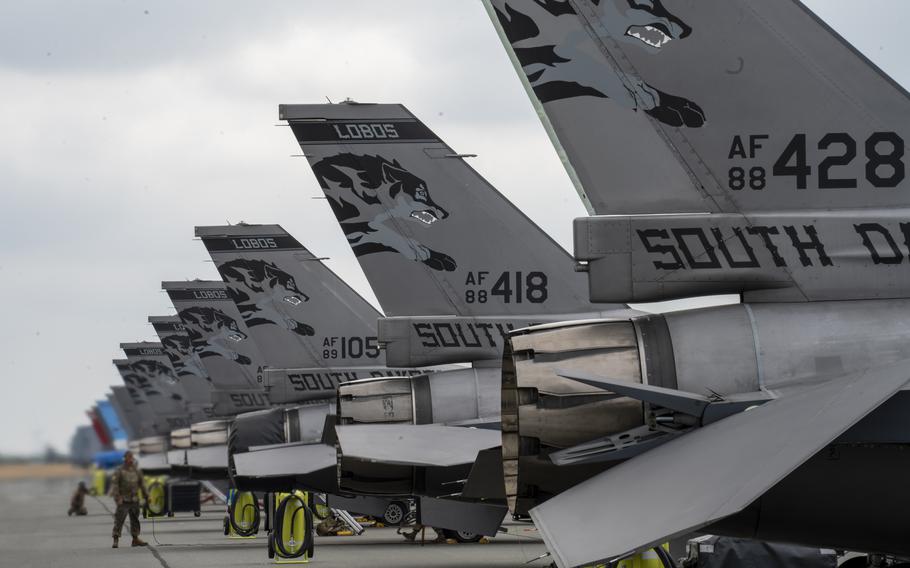
U.S. Air Force F-16 fighter jets sit on the runway at Jagel Airfield in Germany on June 19, 2023. American military aircraft stationed on open airfields could face similar risks as the warplanes destroyed in a recent surprise drone strike by Ukraine deep inside Russia, experts say. (Luke Olson/U.S. Air Force)
U.S. warplanes positioned on open airfields could be vulnerable to attack much like the Russian bombers destroyed during a recent surprise drone strike by Ukraine that carries wider military implications, analysts say.
The mission, dubbed Operation Spiderweb, targeted four bases deep in Russian territory and delivered a severe blow to Moscow’s strategic bomber fleet. It involved swarms of small drones, which hit more than 40 of Russia’s most prized aircraft, Ukrainian officials said.
The operation “demonstrated the growing need for robust physical protection and dedicated countermeasures against drone threats,” Kateryna Bondar, an expert at the Center for Strategic and International Studies in Washington, D.C., wrote in an analysis Monday.
Moreover, Operation Spiderweb highlights how cheap, off-the-shelf technology in the hands of savvy operators can put at risk multibillion-dollar weapons systems that traditionally enjoyed an air of invincibility.
“The militaries that adapt early — by investing in resilience, countermeasures, and adaptive doctrine — will be best positioned to meet the challenges of a rapidly evolving battlefield,” Bondar said. “Together, these trends point to a future where technological agility, not just industrial scale, determines strategic advantage.”
For the U.S. Air Force, the Ukrainian attack inside Russia could serve as a wake-up call and galvanize efforts to harden bases where bombers and fighter planes operate. For years, security analysts have warned that American aircraft are at risk.
The war in Ukraine, where drones have dominated the battlefield, has intensified concerns about how such technology could be turned against the United States.
“Airfields at home and abroad where US forces operate are generally unhardened and highly vulnerable to small strikes,” according to a Hoover Institute report in January that assessed U.S. aircraft vulnerabilities.
The study said the U.S. military now lags behind China when it comes to protecting aircraft on bases, a sign that Beijing realizes such locations could be prime targets.
Meanwhile, key U.S. military sites are also exposed, the study said.
“For example, China could neutralize US military aircraft and fuel stores at Marine Corps Air Station Iwakuni, home to Carrier Air Wing Five — and arguably the most important Marine Corps aviation facility in Japan — with as few as 10 submunition-armed missiles,” the study said.
And Langley Air Force Base in Virginia, home to more than a third of the Air Force’s F-22 fighter fleet, also is vulnerable, the report said.
Some members of Congress have called on the Defense Department to focus more on force protection and hardening of aircraft shelters.
A May 2024 letter signed by 13 members of Congress focused on the mismatch between China and the U.S. in the Pacific.
“U.S. bases in the region have almost no hardened aircraft shelters compared to Chinese military bases,” the letter said.
In Operation Spiderweb, a team of drone operators took advantage of exposed aircraft. It’s likely the Kremlin assumed that the bases, some of which were more than 1,000 miles away from Ukraine, were out of reach.
Mick Ryan, an expert on warfare at the Lowy Institute in Sydney, said the operation should serve as a lesson to militaries about the need to balance acquiring larger numbers of cheap weapons systems and small numbers of high-cost ones that are becoming more vulnerable to quickly deployed drones.
“The latest Ukrainian strikes on Russian airfields will have an influence on the war but are unlikely to change the political calculus of the Russian leader,” Ryan wrote. “However, the attacks are yet another harbinger of future war that many Western military institutions are yet to fully accept.”